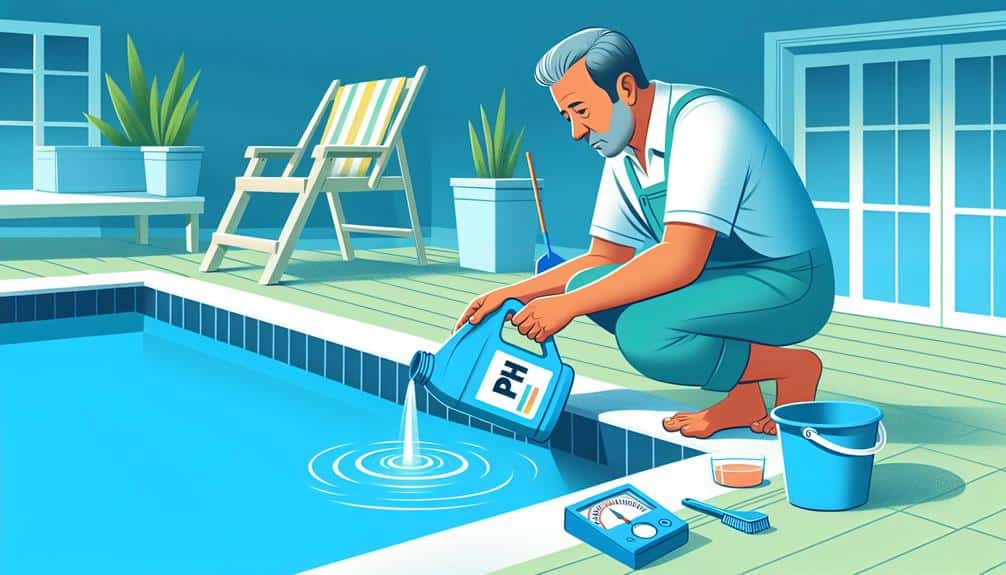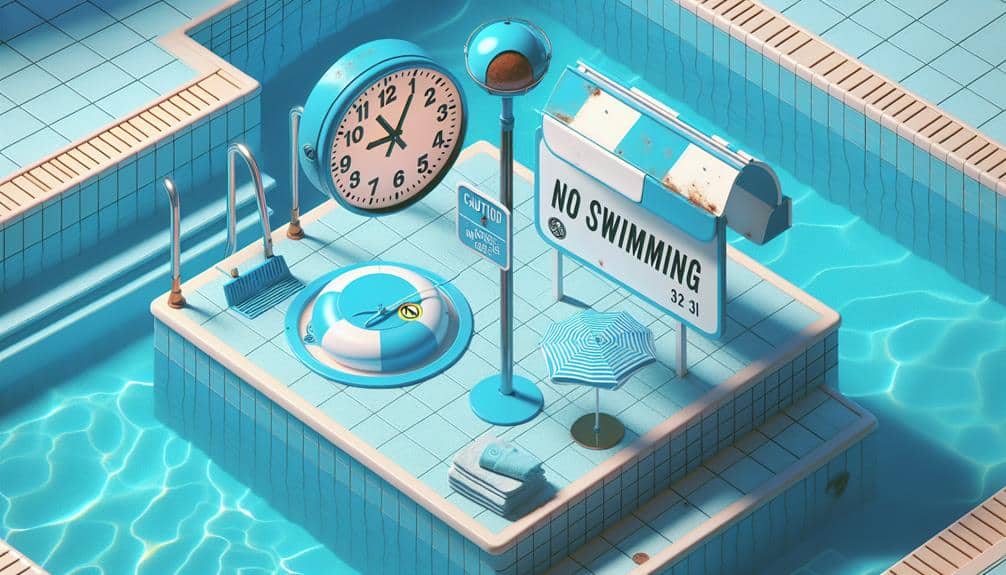When it comes to maintaining the pH levels in your swimming pool, precision is key. Properly balancing the acidity of your pool water not only ensures swimmer comfort but also safeguards the pool equipment from potential damage. By employing the right techniques and products, such as pH reducers and muriatic acid, you can effectively lower the pH levels. But remember, the process doesn’t stop there. There are additional steps you need to consider to maintain a healthy pH balance in your pool. Keep reading to discover these crucial steps for a pristine swimming experience.
Importance of Ph Balance
Maintaining the proper pH balance in your swimming pool is crucial for ensuring the water stays safe and comfortable for swimmers. When the pH level is too high or too low, it can have serious health implications for anyone using the pool. Imbalanced pH levels can cause skin and eye irritation, leading to discomfort and potentially more severe reactions. Additionally, the chemical safety of your pool water is compromised when the pH isn’t within the proper range.
To prevent these issues, it’s essential to regularly test the pH of your pool water and take necessary steps to adjust it as needed. By maintaining the correct pH balance, you not only ensure the health and safety of swimmers but also prolong the lifespan of your pool equipment. Remember, a properly balanced pH level is key to enjoying a clean and refreshing swimming experience.
Test Your Pool Water
When testing your pool water, make sure to use a reliable pH testing kit to accurately measure the acidity or alkalinity levels. Water quality is crucial in maintaining a safe and enjoyable swimming environment. Regularly testing the pH of your pool water is essential to ensure that it stays within the optimal range of 7.2 to 7.6.
pH testing is a simple process that can be done quickly. First, ensure your testing kit isn’t expired as this could lead to inaccurate results. Dip the testing strip or use the liquid reagent to collect a water sample from elbow-depth. Follow the instructions provided with your testing kit to determine the pH level of your pool water accurately.
Monitoring the pH levels of your pool water is vital for the health of your swimmers and the longevity of your pool equipment. By regularly testing and adjusting the pH levels as needed, you can maintain a balanced pool environment and prevent issues caused by imbalanced water chemistry.
Add Ph Decreaser
When adding pH decreaser to your pool, it’s crucial to understand the different types available, follow precise application instructions, and regularly test pH levels for optimal balance.
The type of pH decreaser you choose will depend on your pool’s specific needs and the current pH level.
Ph Decreaser Types
Consider using a pH decreaser to effectively lower the pH level in your swimming pool. When selecting a pH decreaser, keep in mind the following to ensure optimal results:
- Granular pH Reducers: Easy to use and effective for quick pH adjustments.
- Liquid pH Reducers: Immediate results and suitable for precise pH control.
- pH Reducers with Corrosion Inhibitors: Protect pool equipment while lowering pH levels.
- Fast-Acting pH Reducers: Ideal for urgent pH corrections before pool usage.
Application Instructions
To effectively lower the pH level in your swimming pool with a pH decreaser, follow these application instructions.
First, ensure you follow safety precautions by wearing protective gear like gloves and goggles. Start by determining the current pH level using a test kit.
Once you have the reading, calculate the proper dosage needed to lower the pH to the recommended range of 7.2 to 7.6. Refer to the product instructions for the specific amount required based on your pool size.
Slowly pour the pH decreaser around the perimeter of the pool while the filtration system is running to aid in distribution. Allow the product to circulate for a few hours before retesting the pH level.
Testing Ph Levels
For accurate pH testing and adjustment, integrate pH decreaser into the process to maintain your swimming pool water within the ideal range. When testing pH levels, consider the following:
- Utilize Reliable pH Testing Methods: Choose trusted testing kits or electronic testers for accurate results.
- Understand pH Level Fluctuations: Factors like rainwater, debris, and swimmers can affect pH levels.
- Regular Testing Schedule: Test your pool water at least twice a week to catch any fluctuations early.
- Adjust pH Promptly: If the pH deviates from the recommended range, use pH decreaser as soon as possible to prevent further imbalances.
Use Muriatic Acid
Using muriatic acid is a common method to lower pH levels in a swimming pool. When handling muriatic acid, safety precautions are crucial. Always wear protective gear like gloves and goggles to prevent any accidents. Before adding muriatic acid, ensure the pool pump is running to aid in proper distribution.
Proper dosing is essential when using muriatic acid. Start by testing the pH levels of the pool water. Follow the manufacturer’s guidelines for the correct amount of muriatic acid to add based on the pool size and current pH levels. It’s recommended to add the acid in small increments to avoid overshooting the desired pH level.
After adding the muriatic acid, allow some time for it to circulate throughout the pool. Retest the pH levels after a few hours to ensure it has reached the desired range. Remember to store muriatic acid in a cool, dry place away from other chemicals and out of reach of children.
Increase Pool Circulation
Improve pool circulation by adjusting the direction of your pool jets for better water flow. Proper water circulation is essential for maintaining balanced pH levels in your swimming pool. Here are four key steps to enhance water circulation and ensure your pool stays clean and safe:
- Regular Filter Maintenance:
Make sure to clean or replace your pool filter according to the manufacturer’s recommendations. A clean filter helps in efficient water circulation, preventing the buildup of contaminants that can affect pH levels.
- Optimal Jet Positioning:
Adjust the direction of your pool jets to create a circular flow pattern. This helps distribute chemicals evenly and prevents stagnant water areas where pH imbalances can occur.
- Use a Pool Skimmer:
Keep your pool skimmer free of debris to allow for better water intake and circulation. A clean skimmer ensures that surface impurities are removed promptly, helping to maintain pH levels.
- Consider Adding a Water Feature:
Waterfalls or fountains not only enhance the aesthetic appeal of your pool but also aid in improving water circulation. The movement created by these features helps in distributing chemicals effectively throughout the pool.
Monitor Ph Levels Regularly
Regularly monitor the pH levels of your swimming pool to ensure proper water balance and maintenance. pH level fluctuations can occur due to various factors such as rainfall, debris, or the number of swimmers in the pool. These fluctuations can lead to chemical reactions that affect the water quality and overall effectiveness of sanitizers.
To effectively monitor pH levels, invest in a reliable pH monitoring kit. Test the water at least twice a week and make adjustments as needed. Keeping pH levels within the recommended range of 7.2 to 7.6 is crucial for a comfortable swimming experience and to prevent damage to pool equipment and surfaces.
Seek Professional Help if Needed
If you encounter challenges in maintaining the pH levels of your swimming pool, consider seeking professional help to ensure proper water balance and quality. While many issues with pH levels can be resolved using DIY methods, some situations may require professional advice and intervention. Here are some reasons why seeking professional help may be the best course of action:
- Complex Issues: Professional pool technicians have the expertise to diagnose and address complex pH imbalances that may be challenging for a novice to resolve effectively.
- Safety Concerns: pH levels that are too high or too low can pose health risks to swimmers. Professionals can quickly assess the situation and take appropriate measures to ensure a safe swimming environment.
- Prevent Further Damage: Incorrectly adjusting pH levels can lead to damage to pool equipment or surfaces. Professional advice can help prevent costly repairs down the line.
- Time-Saving: Professionals can expedite the process of balancing pH levels, allowing you to enjoy your pool sooner without the frustration of trial and error.
Frequently Asked Questions
Can I Use Household Vinegar to Lower the Ph in My Pool?
You’re considering vinegar for your pool’s pH, right? While it’s a household option, there are better alternatives for pool maintenance. Explore natural remedies to maintain the chemical balance effectively. Keep your pool pristine!
Is It Safe to Swim in a Pool With Low Ph Levels?
Swimming in a pool with low pH levels can pose safety concerns. Skin irritation may occur. Ensure proper ventilation and monitor water quality regularly to prevent health risks. Prioritize safety when it comes to swimming.
How Long Should I Wait to Retest the Ph After Adding Chemicals?
After adding chemicals, wait at least 6-8 hours before retesting pH levels in your pool. It ensures accurate readings since some chemicals need time to fully dissolve and react. Regularly test pH levels to maintain the optimal range and chemical balance for safe swimming conditions.
Can I Use Baking Soda to Raise the Ph in My Pool?
Yes, you can use baking soda to raise the pH in your pool. It is one of the baking soda alternatives for pH level maintenance. Follow guidelines for proper dosing and retest after a while for accuracy.
What Are the Potential Risks of Using Too Much Ph Decreaser?
Using too much pH decreaser in your pool can lead to potential dangers like corrosion of pool equipment, skin and eye irritation, and imbalanced water chemistry. Always follow proper dosage recommendations to avoid these issues.
Conclusion
Just like a delicate dance, maintaining the pH balance in your swimming pool requires attention, precision, and caution. By regularly testing, adjusting, and monitoring the pH levels, you can ensure a harmonious and safe swimming environment for everyone to enjoy.
Remember, the key to a sparkling pool lies in the balance of the unseen forces beneath the surface. Keep up the good work, and may your pool waters always shimmer with clarity and balance.
For expert help with pool maintenance in San Diego, trust our professional team at Pool Service San Diego. Contact us today to keep your pool in top shape and enjoy worry-free swimming all year round!

As the premier provider of pool services in San Diego, CA, our team at Pool Service San Diego specializes in maintenance, repair, and installation. With years of expertise, we’re dedicated to delivering exceptional care and sustainable solutions for your pool’s beauty and health.



